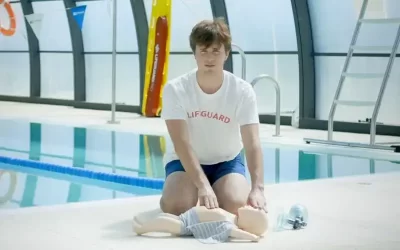Lifeguarding is a challenging yet rewarding profession that requires a diverse skill set to ensure the safety of swimmers in various environments. With the growing importance of water safety, technology advancements, and new challenges that arise every year, it’s vital for lifeguards to adapt and refine their skills. As we move into 2025, lifeguards must be prepared to handle new technologies, deal with emerging trends in water safety, and master the traditional skills that have always been the foundation of the profession. Here are the top lifeguarding skills to master in 2025:
1. Advanced Rescue Techniques
The core responsibility of a lifeguard is to prevent accidents and perform rescues when necessary. However, as water activities become more diverse, lifeguards need to be proficient in a variety of advanced rescue techniques.
In 2025, lifeguard course are expected to be adept at handling more complex situations, such as:
- Spinal injury rescue: Lifeguards must know how to safely extract a victim from the water if they have suffered a spinal injury. This often involves using specialized equipment, like backboards and head immobilizers.
- Multiple victim rescues: In situations where multiple people need help at the same time, lifeguards need to be able to prioritize and execute rescues quickly without compromising safety.
- Non-contact rescues: As the use of technology like drones and remote-controlled boats grows, lifeguards need to master non-contact rescues, which may include the use of throwable rescue aids or even robotic devices to help retrieve swimmers in distress.
2. CPR and First Aid with a Focus on Technology Integration
Cardiopulmonary Resuscitation (CPR) and basic first aid have always been critical skills for lifeguards. However, in 2025, these skills are evolving, with a focus on integrating technology for better outcomes.
- CPR with AED (Automated External Defibrillator): Lifeguards will need to be proficient in using AEDs to restore normal heart rhythm in cases of cardiac arrest. AEDs are now more portable and efficient, with real-time feedback systems guiding lifeguards to deliver high-quality chest compressions.
- Telemedicine for Remote Guidance: In some locations, lifeguards may work with remote medical professionals via telemedicine platforms to get immediate advice on handling medical emergencies. Being able to communicate effectively with these professionals can be a vital lifeguard skill moving forward.
3. Surveillance and Observation Techniques
Maintaining constant vigilance and observing swimmers’ behavior is crucial for preventing accidents before they happen. In 2025, lifeguards are expected to enhance their observational skills with the help of new technologies and methodologies.
- Drones and AI Surveillance: Drones equipped with cameras are becoming common in some larger pools and beach areas, providing lifeguards with aerial views of the swimming area. Artificial Intelligence (AI) systems can also assist lifeguards in monitoring crowds, alerting them to potential risks before they escalate.
- Behavioral Observation: Modern lifeguards are also trained to detect subtle behavioral signs of distress, such as changes in swimming patterns or signs of fatigue. This proactive approach allows lifeguards to prevent drowning incidents before they happen.
4. Water Safety Education and Communication Skills
A large part of being a lifeguard is educating the public on water safety and creating awareness about risks in aquatic environments. In 2025, effective communication skills are more important than ever as lifeguards interact with people from different cultural backgrounds and varying levels of water safety knowledge.
- Public Awareness Campaigns: Lifeguards need to master the art of delivering water safety messages through various platforms, including social media, posters, and public service announcements. Effective communication can significantly reduce the risk of preventable accidents.
- Conflict Resolution: Lifeguards often have to deal with aggressive or non-compliant swimmers. Mastering conflict resolution techniques and knowing how to handle difficult situations calmly and professionally will be essential.
5. Physical Fitness and Endurance
Being a lifeguard is a physically demanding job, and staying in top physical condition is essential for responding to emergencies quickly and effectively. In 2025, lifeguards need to maintain a high level of fitness and agility, as they will be expected to handle more challenging rescues.
- Swimming Speed and Stamina: Lifeguards must be able to swim long distances without tiring, especially in emergencies where they may need to rescue someone far from the shore. This requires a combination of swimming speed and stamina.
- Strength and Agility: In addition to swimming, lifeguards should also be able to carry or drag victims to safety. Strong muscles, especially in the upper body, are essential for pulling a swimmer from the water or assisting with lifting a victim onto a rescue board.
6. Cultural Sensitivity and Diversity Awareness
In a world that is becoming more globalized, lifeguards need to understand and respect the cultural differences and diversity of the people they serve. Being aware of different cultural attitudes toward water safety and having the ability to adapt to various communication styles will be a crucial skill for lifeguards in 2025.
- Language Skills: While not mandatory, learning basic phrases in multiple languages can help lifeguards communicate more effectively with swimmers who may not speak the local language.
- Inclusive Practices: Lifeguards should be trained to recognize and address the needs of diverse groups, such as people with disabilities or non-swimmers, to ensure that water activities remain accessible to everyone.
7. Mental Health Awareness
As awareness of mental health issues grows, lifeguards in 2025 will need to be aware of how psychological factors, such as anxiety or panic, can impact swimmers’ behavior in the water. Being able to recognize the signs of mental distress and knowing how to provide support can be just as crucial as physical rescue skills.
- Recognizing Psychological Distress: Some swimmers may panic in the water due to fear or anxiety. Lifeguards will need to understand how to manage these situations and assist swimmers in regaining their composure.
- Emotional Support: In addition to physical rescue, lifeguards may need to offer emotional support to individuals involved in accidents or to witnesses who may be traumatized.
Finalization
As we approach 2025, the role of the lifeguard is evolving to include a broader range of skills and knowledge, from advanced rescue techniques and the integration of technology to cultural sensitivity and mental health awareness. Lifeguards who master these skills will not only be prepared for the challenges ahead but will also play a crucial role in keeping swimmers safe in an increasingly complex and fast-paced world. Being a lifeguard in 2025 will require a combination of physical fitness, technical expertise, and interpersonal communication, ensuring that they remain an indispensable part of water safety.




